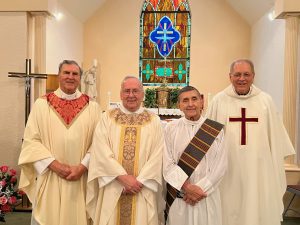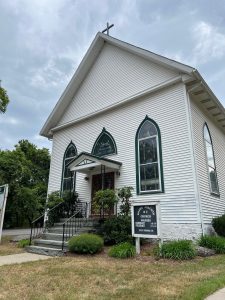MESHOPPEN – Parishioners of Saint Joachim Church gathered on Oct. 13, 2024, to celebrate a Mass of Thanksgiving to mark the 150th anniversary of their house of worship.

Father Patrick L. Albert, Pastor, Nativity of the Blessed Virgin Mary Parish in Tunkhannock, served as principal celebrant of the anniversary Mass. Saint Joachim Church is currently a worship site of Nativity of the Blessed Virgin Mary Parish.
Parishioner Fran Storey Stretch compiled a history of Saint Joachim Church for its 150th anniversary with the help of the following:
The Susquehanna County Historical Society; The Wyoming County Historical Society; Luzerne, Lackawanna and Wyoming County History (1880); Meshoppen Bicentennial Book (1976); Susquehanna County Sesquicentennial Book 1910-1960; Rocket-Courier 100th Anniversary Edition (1987) and Rocket-Courier (1992); Wyoming County Democrat (1874, 1930), Tunkhannock Republican (1873), Tunkhannock New Age (1906) articles contributed by Marjorie Walters; Gail James Loomis House photo; RootsWeb.com collection “Catholic Churches of Susquehanna & Wyoming Counties” which included the Parish’s Centennial Celebration Commemoration Booklet (1973) and “Reminiscences” by first Pastor Rev. P. J. Murphy.
The celebration of the 150th year mark for St. Joachim’s Church, in Meshoppen, is really an affirmation of the Catholic faith from its earliest beginnings in northeastern Pennsylvania. St. Joachim’s is comprised of members from southwestern Susquehanna County, northeastern Wyoming County and southeastern Bradford County, an area the Philadelphia Diocese considered missionary territory in the 1820’s. It wasn’t until 1868 that the Diocese of Scranton was formed.

When hearing the story of Rev. Jeremiah Francis O’Flynn, the first Catholic priest (missionary) who came to northeastern Pennsylvania, it just seems like it was all meant to be. When Rev. O’Flynn had returned from missionary work in the West Indies for health reasons, he met a man in Philadelphia, who had just purchased land in Susquehanna County. This priest wanted to see this rugged land, where a few Irish Catholic families had moved, and a match was made. In 1825, he bought 100 acres near Silver Lake, built a cabin, and added a room where daily masses were held and Sacraments were conferred, by the end of that year. Being a true missionary, Father O’Flynn was soon saying mass in other areas of Susquehanna County. In 1828, he requested, and was granted, (through the Philadelphia Diocese) the pastorate for northeastern Pennsylvania. In 1830 he died in Danville, and, according to reports, 200 Irishmen came to escort his body to Susquehanna County.
The Catholic histories of Auburn and Meshoppen have been interwoven from the very beginning. Ultimately, they were combined into a parish.
It is documented in the history of Wyoming County, printed in 1880, that Meshoppen had masses in homes beginning in 1835, at regular intervals with Rev. Henry Fitzsimmons visiting from Carbondale. Father Fitzsimmons was covering the Friendsville-Silver Lake charge from his Carbondale parish residence. He did four tours a year, covering the Meshoppen/Auburn area. By 1869, masses were being said in Meshoppen monthly. By 1880, thirty-five families were coming to Catholic masses in Meshoppen, according to the Wyoming County History.
The first mass that can officially be documented in Auburn, was said by Rev. John V. O’Reilly, in 1841, in the home of Cornelius Degnan (very close to the current church structure). The home of Felix Reynolds was also utilized for home masses. Father O’Reilly had been assigned to the Friendsville-Silver Lake charge in Susquehanna County in 1838 and stayed with the O’Neill family near Friendsville. Later he moved closer to St Joseph. His appointment in Susquehanna County lasted 35 years, and his missionary work would have included our area, due to its proximity.
There are several indicators that the area around the current St. Bonaventure Church was being utilized during the 1840s and 1850s for Catholic functions, even though the deed for the land, where the current structure sits, wasn’t transferred until 1873. The gravestone for the earliest grave in St. Bonaventure Cemetery is dated 1845. More than one local history says a church was built in 1846 in Auburn Township, and two side wings were added in 1860. The report from the first pastor, Rev. Patrick J. Murphy, who arrived at Auburn in 1873, talks about a church existing there upon his arrival. Notes say, that “Historical data concerning Auburn parish attended first by priests from Friendsville. All records previous to 1874 can be found at Friendsville PA”.
There is a lot of speculation about what happened to the first church in Auburn, and a fire has been suggested through popular recollections. However, there is no doubt that the current St. Bonaventure building was dedicated in 1892.
Two events contributed to the large numbers of Irish immigrants who came to our area during the 1830s-1850s. One was the potato famine in Ireland and the other was the building of the North Branch Canal along the Susquehanna River. These strong Catholic groups within the Meshoppen Auburn area, became the roots of our parish.
So, the stage was set for a new parish to be born. In 1873, the rectory building was completed in Auburn Township. And in 1874, the cornerstone was laid for the St. Joachim’s Church, in Meshoppen. A lot had been purchased from D.T. Sterling, in the back of the Sterling House. At one point, Meshoppen was called Sterlingville, in honor of the successful Meshoppen businessman. The name reverted back to Meshoppen, however, and stayed that way. It is derived from the Native American word “Mashapi” (meaning glass beads), named for special stones/ trinkets that accumulated somewhere on the stream or where the creek meets the Susquehanna River. This location where the creek meets the river was an important location for both the Native Americans and the settlers.
The new church was to be built by T. J. Sherwood, in the orchard between the Depot and the Sterling House, according to a “Wyoming County Democrat” newspaper clipping from 1874. Land was also secured from the Allen Jayne family on Myo Beach Road for a St. Joachim’s Cemetery. The Church was finished in 1875, and the beautiful stained-glass windows were added in 1906, according to a note in the Tunkhannock New Age newspaper.
The first pastor, Rev. P. J. Murphy was assigned to Auburn, which was the main church, and his residence was located next to St. Bonaventure’s Church. Three mission Churches were assigned to Auburn including Meshoppen, Montrose and Tunkhannock. As the years went on and populations grew in the other towns, parishes were formed in Montrose and Tunkhannock. St. Bonaventure and St. Joachim Churches remained linked in a parish, but the rectory was moved to Meshoppen in 1930.
The Loomis House, along with its surrounding grounds, was purchased in 1930, from a descendent of the family for $6,000 to become the Catholic residence. Included was a large carriage house, which was destined to become the parish hall. Under the direction of Rev. Norman J. Monahan and Rev. Francis H. Irwin, the hall was renovated and became known as the “Casino”, a longstanding social gathering place for both the Church and the community of Meshoppen. Father Irwin’s project included enlarging the Casino. The cellar was dug out by hand by the men of the parish and a large addition was added to the back.
At the time of the purchase, Rev. Joseph Reilly, also noted the grounds around the house would provide a lovely spot for parish picnics. That was indeed the case for many years, with the lawn filled with tents for Bingo and other games for the Summer Picnic, and homemade dinners and pies served inside. The St. Patrick’s Day Dinners were also great hits for many years. Monday nights were for Bingo in the Casino in the 1980s for church fundraising. For thirty-three year, roast beef was cooked at the Casino to be sold at the Wyoming County Fair as a major fundraiser. The Casino still holds many parish events, including the annual parish Christmas party, and fundraisers such as the Elimination Party, and the “Taste of the Fair” each year.
The rectory (Loomis House) was sold in the early 1980s, and a smaller home was placed on the St. Joachim’s Church lot, to serve as a rectory for the priest.
St. Joachim’s Church almost seems to have a protective cloak around it, as it has survived three major floods and several major fires in Meshoppen. The closest fires were the four mill fires across the street. The heat from the 1923 fire threatened the church and the last fire in 1930 was so intense that it scorched the St. Joachim’s Church building. A 1943 fire in the center of Meshoppen took out 14 businesses, including a few on Route 6, and the rest being on the north and south sides of Bridge St. (toward Route 6). But again, the Church was safe and sound, a little away from that section of town.
The Casino being lower and closer to the Meshoppen Creek and Susquehanna River, sustained serious flooding in 1936, 1972, and 2011, taking on water onto the main floor. However, St. Joachim’s Church just being slightly higher and away, has never flooded onto the main floor of the church. The water has come close to the building, and some basement water was received, but the church remained unscathed.
The Casino needed extensive renovations after the 1972 flood, and parishioners also helped to fund those needed repairs. The last major project completed at the Casino, was an addition to the main floor for a beautiful kitchen and new bathrooms.
In the 1980s, St. Joachim’s Church also underwent a major construction project with additions of a brighter bigger altar area, a balcony and additional seating.
With the influx of Eastern European immigrants from 1900-1925, the ranks of this parish expanded and diversified from its original Irish roots. Polish, Italian, Lithuanian, and other Slavic nationalities joined the Irish with their same strong faith, as well as others.
With the 1960s, came the building of the one of the largest Procter & Gamble plants in the U.S., just over the hill in Mehoopany. A general boost to the economy came along with P & G, but only a slight increase to church membership. Still a growing parish, at the time of the St. Bonaventure Church Building Anniversary in 1992, there were 330 families in the parish.
Over the last decade, St. Joachim’s has welcomed many new members of the Hispanic nationality. Their devout faith and presence are great blessings. On the first and third Sundays of each month, Rev. Kevin Miller says mass in Spanish at 3 pm. These masses are in addition to the 9 am services every Sunday morning.
In 2009, St. Bonaventure Church was closed, and St. Joachim’s parish was merged with St. Mary’s of the Assumption Parish in Wyalusing. The two parishes were joined into a new parish named “Our Lady of Perpetual Help”. At that time, St. Anthony’s Church in Stowell, the mission church of Wyalusing, was also closed, which brought some additional members to Meshoppen. Since 2009, there has not been a priest in residence, or a church office, in Meshoppen. But St. Joachim’s has retained weekly masses and all of the benefits of the Catholic faith, through the Sacraments and help of the priests who attend to its families. The previous rectory is now used as an education building for CCD. The “hallmark” coffee and donuts social time is still held after Sunday mass in the basement of that building, as it has been since the 1980s.
In 2022, a change was made and St. Joachim’s Church is now joined to the Nativity of the Blessed Virgin Mary Parish in Tunkhannock, PA. Again, new folks are welcomed to St. Joachim’s masses in Meshoppen. In addition to Sunday services, St. Joachim’s Church still has a weekday mass on Thursday morning at 9 am, and Holy Day masses. The congregation is faithfully served by Rev. Patrick L. Albert, Deacon Raymond Pieretti, Rev. Dennis Bajkowski, and Rev. Kevin Miller.
